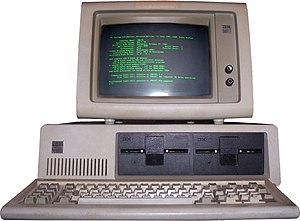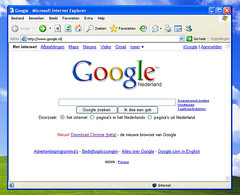By Carl Weiss
When it comes to
revolutionizing the way in which we perceive and operate in the world as we
know it, the Internet has without a doubt been one of the most important
inventions ever created. And like many
inventions, the web was the result of a lot of labor by a number of talented
people. Some of those people wound up
being relegated to footnote status while others went onto become Internet
icons.
The Internet was actually an
outgrowth of the ARPANET, which was a cold war project designed to safeguard government
communications in case of nuclear attack by the Soviet Union. Developed in the sixties and seventies, the ARPANET
program led to t a number of internet protocols such as TCP/IP
that formed the foundation for internetworking that we all use today.
| wozniak_jobs (Photo credit: Revolweb) |
The only problem was that
back in the sixties and through much of the seventies, the only people who had
access to computers were governments, fortune 500 companies and
universities. Then in 1976 a couple of
guys named Steve invented and began selling one of the first practical microcomputers, called the Apple. The problem
back then was that these fledgling computers were not very powerful and they
were expensive. The first Apple sold
for $666.66. This was at a time when
many compact cars sold for a couple thousand dollars.
Add to this the fact that
their computer didn’t do a lot and it was obvious that they would have to woo a
number of software developers. Some of
these included Fred Gibbons, Mitch Kapor and Bill Gates. While people think of Microsoft as being a
mortal enemy of Apple, back then the two were kissing cousins. It wasn’t until a few years later with the
advent of the IBM PC that the lines were drawn in the sand between Apple vs PC and the two wound up in opposing camps.
In the early days not only did every Apple computer come equipped with
Gate’s version of Basic, but in a 1983 interview Bill stated that he
expected to generate half of Microsoft’s revenues in 1984 from Macintosh
software alone.
While many people don’t instantly
recall who Fred Gibbons and Mitch Kapor were back then, their contributions
kept Apple’s train on the tracks during the early half of the eighties. Fred’s company Software Publishing Company
created a number of software products, chief among them being Harvard Graphics,
which brought on-screen graphics capabilities to early versions of the Apple.
Mitch Kapor developer of
Lotus 1-2-3 was one of the rock stars of software development in the early days
of personal computing. In fact Lotus
1-2-3 became one of microcomputing’s first killer apps which would eventually
contribute to the popularity of Apple’s nemesis, the IBM PC. That doesn’t mean that there weren’t other
software developers on the hunt for other killer apps. In fact, Lotus 1-2-3 was an offshoot of
another earlier spreadsheet program called Visicalc.
Of course, competition among
software developers was not the only place where the microcomputer war was
heating up. Back then there were a
number of companies trying to muscle in on the hardware game as well. Chief among them was Tandy Radio Shack whose
TRS-80 was a popular brand at the time.
(Although it didn’t help that denigrators of the brand used to refer to it
as the Trash Eighty.) The Commodore 64
was another successful brand, selling some 17 million units sold.
| The first developers of IBM PC computers neglected audio capabilities (first IBM model, 1981). (Photo credit: Wikipedia) |
This is when the titan of
computer manufacturing decided to get into the game with a micro of its
own. By 1980 more than 50 microcomputer
systems were on the market. This is when
IBM decided it was time to join the fray.
Before 1981, IBM was the dominant player when it came to mainframe
computers. They had never even
considered creating a microcomputer. In
fact, so sudden was their entry into this burgeoning market that they did
something unprecedented. Instead of
taking the time to create an entirely proprietary product, they instead cobbled
together the IBM PC with mostly off-the-shelf technology. (They didn’t even have an operating system
for a PC, which opened the door for Bill Gates whose MS-DOS system quickly
became the defacto operating system for the IBM PC along with an eventual swarm
of clones.)
So many competitors began to
pile on that even those who had enjoyed hegemony during the early going (such
as Apple) began to feel the heat. By
1982, the marketplace had reached critical mass and a shakeout was
inevitable. Not wanting to wind up
kicked to the curb, Steve Jobs at Apple decided it was time to reinvent itself
by once again looking into the crystal ball to determine where personal computing
was headed. So taking $50 million of the
company’s money, Steve assembled a team of the best and brightest at Apple and
created what he thought would be the next leap forward in personal computing
technology. Called Lisa, the computer
was released in January of 1984 priced
between $3,495 and $5,495. Even though the system
was well ahead of its time, commercially its launch was hailed as a failure,
one that would ultimately cost Jobs his job. (The release later that year of
the Macintosh, which was both faster and cheaper saved Apple from joining the
technological scrap heap wherein many of its competitors wound up.)
This
failure did not deter Jobs, who along with several other ousted Apple employees
went onto start NeXT Computer, Inc. in 1995.
While NeXT only sold around 50,000 units and was ultimately absorbed by
Apple for $429 million, several of the concepts developed at NeXT were incorporated
into later Apple systems, including parts of the OS X and IOS operating
systems. During his hiatus from Apple,
Steve Jobs also dabbled with another company called Pixar, in which even George
Lucas had lost faith. Pixar would
later go onto produce a number of animated features some of which would receive
Academy awards. Jobs also clearly had a
bead on the NeXT big trend of the 1990’s which he referred to as interpersonal
computing that would soon appear with an eerily similar moniker: The Internet.
The
term Internet was actually coined back in 1974 as an abbreviation to the term
“internetworking”. Of course, at that
time, the only entities internetworking were military sites and
universities. However, by the 1980’s
NASA joined the fray by developing the NASA Science Network which allowed
scientists to share data on a global basis.
This eventually coalesced into the NASA Science Internet, which
eventually connected more than 20,000 scientists worldwide. As interest in worldwide networking grew, the
technology spawned other early adopters, such as Usenet, UUCPNet, FidoNet,
JUNET and NSFNET. During the late
1980’s the first Internet service providers were formed, starting with the
first commercial dialup service in the US called The World.
By
the early 1990’s search engines such as Archie and Gopher sprung up, along with
the first web browsers, such as ViolaWWW.
While a far cry from the multi-media offerings we have come to know and
expect today, these early search engines and browsers offered little more than
text-only listings more reminiscent of Craigslist than Google. That did not mean that there wasn’t market
share to be had.
As
the World Wide Web grew, search engines and web directories began to spring up
like weeds with such names as WebCrawler, Lycos, HotBot, Excite, Yahoo (founded
in 1994) and AltaVista. Also several new
web browsers hit the market, the most notable of which was Netscape, that
appeared in 1994. Clearly a cut above
other web browsers, Netscape Navigator was the gold standard for surfing the
web in the 1990’s. In fact the product
was such a hit that only 16 months after its inception, the company went public
with its stock soaring from $28 to $58 on the opening day. It also began the feeding frenzy later called
the Tech Bubble that would run rampant for the next six years creating a number
of billionaires in the process.
One
such billionaire definitely took notice of Netscape in a big way. Bill Gates at Microsoft knew a good thing
when he saw it. And he knew that
Microsoft had to stake a claim on the Internet.
By August of 1995 Microsoft announced the introduction of Internet
Explorer 1.0. While it took Microsoft
more than 5 years to gain the upper hand over Netscape, their dominance in the operating
system market opened the doors for them to chip away at Netscape’s market
share. So much so that by June of 2006
netscape.com went dark for good. That
would seem like good news to Bill at Microsoft.
It probably would have been had it not been for one other upstart named
Google.
Begun
in March of 1996 as a research project by two Stanford students named Larry
Page and Sergey Brin, their original idea had not been to design a web browser
or search engine for that matter. What
they were out to develop was the world’s first digital library. In search of a dissertation theme, Page
considered exploring the mathematical properties of the Internet by turning its
structure into a gigantic graph. Page’s
web crawling software called BackRub began exploring the web autonomously with
Page’s own website serving as ground zero.
His research along Brin’s help eventually morphed into an algorithm that
the pair named PageRank, which became the nexus for their Google search engine,
which was registered on September 15, 1997.
| Google Chrome (Photo credit: thms.nl) |
By
December 1998, Google had an index of about 60 million pages. But already a number of Internet gurus were
arguing that Google’s search results were superior to those of its
competitors. In March 1999 the company
moved to Palo Alto. In June of that same
year they secured $25 million in equity capital from venture capital firms Kleiner
Perkins Caulfield and Sequoia Capital.
While Brin and Page were hesitant to take the company public, it was
Google’s IPO on August 19, 2004 that shook the pillars of the Internet that
would ultimately see Google as not only the dominant search engine online, but
it would also enable the company to own the world’s most popular web browser
(Chrome), the world’s most popular video portal (YouTube) and the world’s most
popular cellphone operating system (Android).
Of
course, like a many innovators that came before them, that doesn’t mean that
the latest successors to the Internet crown are always omniscient. Several of Google’s latest tech forays have
yet to come to roost, including a computer worn on your face (Google Glass), a
pair of mysterious barges berthed in San Francisco Bay and Maine, and
communication blimps that are designed to bring the Internet to sub- Saharan
Africa.
Not
to be outdone, Apple announced a product a year ago that while intriguing has
yet to hit the market called the iWatch.
Love them or hate them, one thing you can say about the smartest guys in
the room is that they will never leave you bored. I can’t wait to see what comes NeXT.
Carl Weiss
is president of W Squared Media Group, a digital media agency located in
Jacksonville, Florida. He is also
co-host of Working the Web To Win that is broadcast on BlogTalkRadio and
YouTube every Tuesday at 4 pm Eastern.






No comments:
Post a Comment